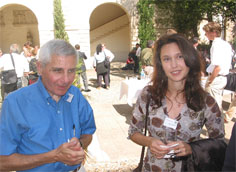 Professor Emeritus
Professor Emeritus
Department of Cell Biology
Education and Training
B.S., St. Joseph’s College
Ph.D., University of Pennsylvania
Contact
Phone: 860-679-2410
Fax: 860-679-3693
Email: pappano@uchc.edu
Office: L5023
UConn Health
263 Farmington Avenue
Farmington, CT 06030
Research Interests
We are studying the mechanism(s) for the protective effect of an ATP receptor in a murine heart failure model. Transgenic cardiac overexpression of the calcium binding protein calsequestrin (CSQ) is associated with premature death. Endogenous ATP activates the P2X4 receptor (P2X4R), an ion channel receptor present in the mammalian heart. Overexpression of the human P2X4R is accompanied by increased contractile force in vivo and increased cell shortening in vitro. Transgenic animals that overexpress both the hP2X4R and CSQ are protected against heart failure; average life-span is increased by 4-5 weeks. Among the three factors regulating excitation-contraction coupling, we identified increased sarcoplasmic reticulum (SR) calcium content as contributing to the rescue effect. This effect is associated with increased intracellular calcium release by ATP. The increased SR calcium content stems from a reaction in which ATP promotes sodium entry via plasmalemmal P2X4R, the cell exchanges internal sodium for calcium at the sodium/calcium exchanger and the increased internal calcium is stored in the SR. Neither the L-type calcium current nor myofilament calcium sensitivity is affected by ATP when hP2X4R is overexpressed. Also, cAMP content is unaffected by ATP. In a heart failure model caused by ligation of the left anterior descending coronary artery, overexpression of the hP2X4R resulted in a greater contraction force and left ventricular developed pressure than in hearts from wild type mice and also increased survival at 1 and 2 months after ligation. There was no difference in the sizes of the infarcted tissue. Thus, rescue of animals from heart failure caused by two different means is ascribed to improved contractile performance dependent upon increased SR calcium.
Recent Publications
Shen J-B, Yang R, Pappano A and Liang BT: Cardiac P2X receptors as a new pathway for increasing Na+ entry in cardiac myocytes. Am J Physiol 307:H1469-1477, 2014.
Pappano A: Letter to the Editor: Cardiomyocyte-secreted acetylcholine. FASEB J 28:1-2, 2014.
Pappano, A.J. and Wier, W.G. (2013) Cardiovascular Physiology, (10th edition), Elsevier Publishers, Philadelphia.
Pappano, A.J. (2012) “Cholinoceptor-Blocking Drugs” in Basic & Clinical Pharmacology, (12th edition), ed. by Katzung, B.G., Masters, S.B., and Trevor, A.J., pp. 115-128, McGraw-Hill, New York.
Pappano, A.J. (2012) “Cholinergic-Activating & Cholinesterase-Inhibiting Drugs” in Basic & Clinical Pharmacology (12th edition), ed. by Katzung, B.G., Masters, S.B., and Trevor, A.J., pp. 97-113, McGraw-Hill, New York.
Zhou S-Y, Mamdani, M., Qanud, K., Shen, J-B, Pappano, A.J., Kumar, S.T., Jacobson, K.A., Hintze, T., Recchia, F., and Liang, B.: 2010. Treatment of heart failure by a methanocarba derivative of adenosine monophosphate: Implication for a role of cardiac P2X purinergic receptors. J Pharmacol Exp Ther 333:920-928.
Wu, G.Y. and Pappano, A. (eds.) (2009) Pocket Handbook of GI Pharmacotherapeutics, Humana Press, New York.
Shen, J-B, Shutt, R., Agosto, M., Pappano, A., and Liang, B.T.: 2009. Reversal of cardiac myocyte dysfunction as a unique mechanism of rescue by P2X4 receptors in cardiomyopathy. Am J Physiol 296: H1089-H1095.
Pappano A.J. (2008) “Section IV: The Cardiovascular System” in Berne and Levy’s Physiology (6th edition), ed. by Koeppen, B.M. and Stanton, B.A., Elsevier Publishers, Philadelphia.
Sonin, D., Zhou, S-Y, Cronin, C., Sonina, T., Wu, J., Jacobson, K.A., Pappano, A.J., and Liang, B.T.: 2008. Role of P2X purinergic receptors in the rescue of ischemic heart failure. Am J Physiol 295: H1191-H1197.